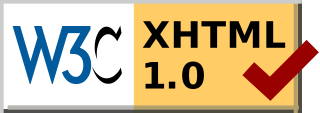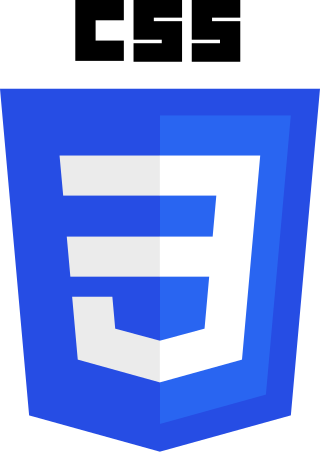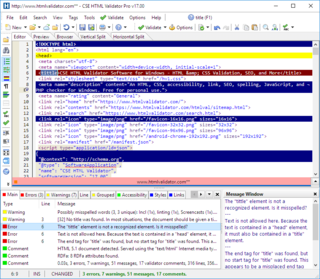Web standards are the formal, non-proprietary standards and other technical specifications that define and describe aspects of the World Wide Web. In recent years, the term has been more frequently associated with the trend of endorsing a set of standardized best practices for building web sites, and a philosophy of web design and development that includes those methods. [1]
Web standards include many interdependent standards and specifications, some of which govern aspects of the Internet, not just the World Wide Web. Even when not web-focused, such standards directly or indirectly affect the development and administration of web sites and web services. Considerations include the interoperability, accessibility and usability of web pages and web sites.
Web standards consist of the following:
More broadly, the following technologies may be referred to as "web standards" as well:
Web standards are evolving specifications of web technologies. [10] Web standards are developed by standards organizations—groups of interested and often competing parties chartered with the task of standardization—not technologies developed and declared to be a standard by a single individual or company. It is crucial to distinguish those specifications that are under development from the ones that already reached the final development status (in case of W3C specifications, the highest maturity level).
The earliest visible manifestation of the web standards movement was the Web Standards Project, launched in August 1998 as a grassroots coalition fighting for improved web standards support in browsers. [11]
The web standards movement supports concepts of standards-based web design, including the separation of document structure from a web page or application's appearance and behavior; an emphasis on semantically structured content that validates (that is, contains no errors of structural composition) when tested against validation software maintained by the World Wide Web Consortium; and progressive enhancement, a layered approach to web page and application creation that enables all people and devices to access the content and functionality of a page, regardless of personal physical ability (accessibility), connection speed, and browser capability.
Prior to the web standards movement, many web page developers used invalid, incorrect HTML syntax such as "table layouts" and "spacer" GIF images to create web pages — an approach often referred to as "tag soup". Such pages sought to look the same in all browsers of a certain age (such as Microsoft Internet Explorer 4 and Netscape Navigator 4), but were often inaccessible to people with disabilities. Tag soup pages also displayed or operated incorrectly in older browsers, and required code forks such as JavaScript for Netscape Navigator and JScript for Internet Explorer that added to the cost and complexity of development. The extra code required, and the lack of a caching page layout language, made web sites "heavy" in terms of bandwidth, as did the frequent use of images as text. These bandwidth requirements were burdensome to users in developing countries, rural areas, and wherever fast Internet connections were unavailable.
The Web Standards movement pioneered by Glenn Davis, George Olsen, Jeffrey Zeldman, Steven Champeon, Todd Fahrner, Eric A. Meyer, Tantek Çelik, Dori Smith, Tim Bray, Jeffrey Veen, and other members of the Web Standards Project replaced bandwidth-heavy tag soup with light, semantic markup and progressive enhancement, with the goal of making web content "accessible to all". [12]
The Web Standards movement declared that HTML, CSS, and JavaScript were more than simply interesting technologies. "They are a way of creating Web pages that will facilitate the twin goals of sophisticated and appropriate presentation and widespread accessibility." [12] The group succeeded in persuading Netscape, Microsoft, and other browser makers to support these standards in their browsers. It then set about promoting these standards to designers, who were still using tag soup, Adobe Flash, and other proprietary technologies to create web pages.
In 2007, Douglas Vos initiated the Blue Beanie Day, inspired by Jeffrey Zeldman, who is shown with a blue cap on the book cover of his 2003 book Designing with Web Standards. [13] Since then, the 30 November is the annual international celebration of web standards and web accessibility. [14]
When a web site or web page is described as complying with web standards, it usually means that the site or page has valid HTML, CSS and JavaScript. The HTML should also meet accessibility and semantic guidelines. Full standard compliance also covers proper settings for character encoding, valid RSS or valid Atom news feed, valid RDF, valid metadata, valid XML, valid object embedding, valid script embedding, browser- and resolution-independent codes, and proper server settings.
When web standards are discussed, the following publications are typically seen as foundational:
Web accessibility is normally based upon the Web Content Accessibility Guidelines [17] published by the W3C's Web Accessibility Initiative.
Work in the W3C toward the Semantic Web is currently focused by publications related to the Resource Description Framework (RDF), Gleaning Resource Descriptions from Dialects of Languages (GRDDL) and Web Ontology Language (OWL).
A W3C Recommendation is a specification or set of guidelines that, after extensive consensus-building, has received the endorsement of W3C Members and the Director.
An IETF Internet Standard is characterized by a high degree of technical maturity and by a generally held belief that the specified protocol or service provides significant benefit to the Internet community. A specification that reaches the status of Standard is assigned a number in the IETF STD series while retaining its original IETF RFC number.
HTML 5 contains numerous "willful violations" of other specifications, in order to accommodate limitations of existing platforms. [18]
There are compliance tests both for HTML code generated by websites as well as for the faithful interpretation of HTML code by web browsers.
W3C offers online services to test websites directly for both web site developers, as well as for website users. These include:
The Web Standards Project (WaSP), although development is officially inactive, continues to offer two levels of testing services for web browsers:

Hypertext Markup Language (HTML) is the standard markup language for documents designed to be displayed in a web browser. It defines the content and structure of web content. It is often assisted by technologies such as Cascading Style Sheets (CSS) and scripting languages such as JavaScript.

The World Wide Web is an information system that enables content sharing over the Internet through user-friendly ways meant to appeal to users beyond IT specialists and hobbyists. It allows documents and other web resources to be accessed over the Internet according to specific rules of the Hypertext Transfer Protocol (HTTP).

Extensible Markup Language (XML) is a markup language and file format for storing, transmitting, and reconstructing arbitrary data. It defines a set of rules for encoding documents in a format that is both human-readable and machine-readable. The World Wide Web Consortium's XML 1.0 Specification of 1998 and several other related specifications—all of them free open standards—define XML.
An HTML editor is a program used for editing HTML, the markup of a web page. Although the HTML markup in a web page can be controlled with any text editor, specialized HTML editors can offer convenience, added functionality, and organisation. For example, many HTML editors handle not only HTML, but also related technologies such as CSS, XML and JavaScript or ECMAScript. In some cases they also manage communication with remote web servers via FTP and WebDAV, and version control systems such as Subversion or Git. Many word processing, graphic design and page layout programs that are not dedicated to web design, such as Microsoft Word or Quark XPress, also have the ability to function as HTML editors.
An HTML element is a type of HTML document component, one of several types of HTML nodes. The first used version of HTML was written by Tim Berners-Lee in 1993 and there have since been many versions of HTML. The current de facto standard is governed by the industry group WHATWG and is known as the HTML Living Standard.
In web development, "tag soup" is a pejorative for HTML written for a web page that is syntactically or structurally incorrect. Web browsers have historically treated structural or syntax errors in HTML leniently, so there has been little pressure for web developers to follow published standards. Therefore there is a need for all browser implementations to provide mechanisms to cope with the appearance of "tag soup", accepting and correcting for invalid syntax and structure where possible.

The Markup Validation Service is a validator by the World Wide Web Consortium (W3C) that allows Internet users to check pre-HTML5 HTML and XHTML documents for well-formed markup against a document type definition (DTD). Markup validation is an important step towards ensuring the technical quality of web pages. However, it is not a complete measure of web standards conformance. Though W3C validation is important for browser compatibility and site usability, it has not been confirmed what effect it has on search engine optimization.
JSON is an open standard file format and data interchange format that uses human-readable text to store and transmit data objects consisting of attribute–value pairs and arrays. It is a commonly used data format with diverse uses in electronic data interchange, including that of web applications with servers.
In computer hypertext, a URI fragment is a string of characters that refers to a resource that is subordinate to another, primary resource. The primary resource is identified by a Uniform Resource Identifier (URI), and the fragment identifier points to the subordinate resource.
The Web Standards Project (WaSP) was a group of professional web developers dedicated to disseminating and encouraging the use of the web standards recommended by the World Wide Web Consortium, along with other groups and standards bodies, with a primary focus on web clients.
In computing, quirks mode is an approach used by web browsers to maintain backward compatibility with web pages designed for old web browsers, instead of strictly complying with web standards in standards mode. This behavior has since been codified, so what was previously standards mode is now referred to as simply no quirks mode.

HTML5 is a markup language used for structuring and presenting hypertext documents on the World Wide Web. It was the fifth and final major HTML version that is now a retired World Wide Web Consortium (W3C) recommendation. The current specification is known as the HTML Living Standard. It is maintained by the Web Hypertext Application Technology Working Group (WHATWG), a consortium of the major browser vendors.
The Web Hypertext Application Technology Working Group (WHATWG) is a community of people interested in evolving HTML and related technologies. The WHATWG was founded by individuals from Apple Inc., the Mozilla Foundation and Opera Software, leading Web browser vendors in 2004.
Extensible HyperText Markup Language (XHTML) is part of the family of XML markup languages which mirrors or extends versions of the widely used HyperText Markup Language (HTML), the language in which Web pages are formulated.

Cascading Style Sheets (CSS) is a style sheet language used for specifying the presentation and styling of a document written in a markup language such as HTML or XML. CSS is a cornerstone technology of the World Wide Web, alongside HTML and JavaScript.

CSS HTML Validator is an HTML editor and CSS editor for Windows that helps web developers create syntactically correct and accessible HTML/HTML5, XHTML, and CSS documents by locating errors, potential problems like browser compatibility issues, and common mistakes. It is also able to check links, check spelling, suggest improvements, alert developers to deprecated, obsolete, or proprietary tags, attributes, and CSS properties, and find issues that can affect search engine optimization.
XHTML+RDFa is an extended version of the XHTML markup language for supporting RDF through a collection of attributes and processing rules in the form of well-formed XML documents. XHTML+RDFa is one of the techniques used to develop Semantic Web content by embedding rich semantic markup. Version 1.1 of the language is a superset of XHTML 1.1, integrating the attributes according to RDFa Core 1.1. In other words, it is an RDFa support through XHTML Modularization.
The Web platform is a collection of technologies developed as open standards by the World Wide Web Consortium and other standardization bodies such as the Web Hypertext Application Technology Working Group, the Unicode Consortium, the Internet Engineering Task Force, and Ecma International. It is the umbrella term introduced by the World Wide Web Consortium, and in 2011 it was defined as "a platform for innovation, consolidation and cost efficiencies" by W3C CEO Jeff Jaffe. Being built on The evergreen Web has allowed for the addition of new capabilities while addressing security and privacy risks. Additionally, developers are enabled to build interoperable content on a cohesive platform.
Front-end web development is the development of the graphical user interface of a website through the use of HTML, CSS, and JavaScript so users can view and interact with that website.
A uniform resource locator (URL), colloquially known as an address on the Web, is a reference to a resource that specifies its location on a computer network and a mechanism for retrieving it. A URL is a specific type of Uniform Resource Identifier (URI), although many people use the two terms interchangeably. URLs occur most commonly to reference web pages (HTTP/HTTPS) but are also used for file transfer (FTP), email (mailto), database access (JDBC), and many other applications.